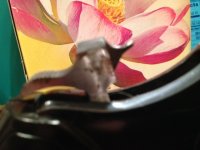cajundefender
Inactive
I recently inherited a neglected Colt Detective special. I cleaned it pretty well tonight, but the hammer is covered in what looks to be some pitting from rust. How you you think that I should fix this, and does it even need fixing? Also, the part of the revolver where the hinge is that connects the cylinder and the frame has a rust colored substance on it that wipes right off when I leave the cylinder closed and then open it after a few days, but I am not sure how to correct this. I am under the impression that there is rust inside the hinge, but I don't know what to do about it but oil it well. This is my pride of all of the revolvers I recently inherited, and it is of course the only one with any problems... My luck... Any help would be appreciated. See the blurry picture for an idea of what I am looking at on the hammer. Nothing wipes off with the solvent so I don't think it is rusting on the hammer, but I still don't like it.

